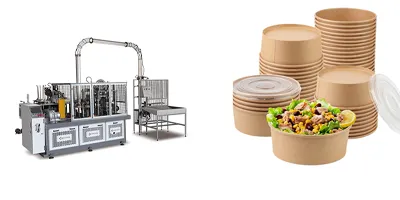The working process of the paper bowl machine is a multi-step and precisely coordinated process aimed at efficiently and high-quality producing paper bowls.
Automatic Paper Feeding Stage
After the paper bowl machine is started, through the precise cooperation of the mechanical structure and the automatic control system, it automatically grabs single PE or double PE coated paper from the paper storage area. The paper needs to meet the grammage requirement of 150 - 350g/m² to ensure the subsequent forming quality. For example, when producing large-capacity soup bowls, paper with a slightly higher grammage is selected to ensure strength; while for small salad bowls, relatively lower grammage paper can be chosen to control costs. The paper feeding action is accurate and uniform, laying the foundation for subsequent forming. The paper feeding speed varies according to the machine model. For example, the XC - B90 model is 60 - 80 pieces per minute. Its speed is dynamically adjusted by the built-in motor drive and intelligent speed regulation system according to production instructions and equipment load, ensuring continuous and stable paper supply, preventing paper jams or interruptions, and maintaining the production rhythm.
Preheating Treatment Stage
After the paper reaches the preheating position, the heating elements apply heat precisely. According to the characteristics of the paper and production requirements, the temperature is raised to an appropriate temperature range, usually [X] degrees Celsius (slightly adjusted according to the size of the paper bowl and the composition of the paper). This process softens the paper fibers, improves their plasticity and flexibility, enhances the forming effect, reduces the risk of cracking during subsequent processing, and optimizes the structural integrity and stiffness of the paper bowl, creating conditions for precise forming. The preheating time is intelligently set according to the paper bowl specification and machine model and is monitored and adjusted in real-time by the PLC system.
Sealing and Forming Step
After preheating, the paper is moved to the forming die area, and the upper and lower dies are accurately closed according to the preset program. Under the action of pressure, the paper is formed according to the contour of the die with a micron-level alignment accuracy, ensuring uniform thickness and regular shape of the bowl wall. The temperature and pressure of the die are dynamically adjusted according to the design parameters of the paper bowl. For example, when producing large-capacity instant noodle bowls, the pressure is increased to ensure a tight seal and a firm bottom; for small paper bowls, the pressure is appropriately reduced to prevent damage caused by excessive compression. This process uses a hydraulic or pneumatic system to provide stable power to achieve efficient and reliable forming. The forming cycle is completed within a few seconds depending on the machine model and the complexity of the paper bowl, ensuring a balance between production efficiency and quality.
Oiling Process
The formed paper bowl is transferred to the oiling station, and silicone oil is evenly coated on the inner surface of the bowl to reduce the possibility of food sticking to the paper bowl and facilitate loading and demolding. The oiling system accurately controls the oil output and coating range according to the bowl type and production speed. It adopts spray nozzle atomization or roller coating technology to ensure uniform distribution and appropriate thickness of the silicone oil. In the spray nozzle type, silicone oil droplets are accurately output through a pressure pump and a flow regulating valve; in the roller type, the rotation speed and pressure of the roller are adjusted according to the curvature of the bowl wall and the moving speed to achieve uniform coating. The quality of the oiling affects the appearance and user experience of the paper bowl, and this process is strictly controlled.
Bottom Cutting and Processing
After oiling, the paper bowl is moved to the cutting area, and the cutting tool accurately cuts the excess paper at the bottom according to the set size and shape, ensuring a flat and smooth bottom with a dimensional tolerance within millimeters. The bottom may undergo special treatments such as embossing to enhance compressive resistance and anti-slip properties, and curling to beautify the appearance and improve the edge strength. The embossing and curling dies are customized according to the design, and the processing parameters are intelligently set by the control system according to the product specification, ensuring stable and uniform quality of the bottom processing of each paper bowl and improving the overall quality and functionality of the paper bowl.
Finished Product Collection Stage
The processed paper bowls are orderly transferred to the collection area through the conveyor belt and stacked and sorted according to the set quantity and packaging requirements. The collection system is equipped with sensors to monitor the quantity and state. When the preset quantity is reached, the packaging process is automatically started or a new collection container is used to ensure continuous and orderly production, prevent the backlog and damage of finished products. The collection speed is adapted to the production efficiency to ensure a smooth transition of the paper bowls from the production line to the packaging link. Finally, the finished products are packaged into boxes and ready for shipment, completing the entire production process of the paper bowl.The processed paper bowls are orderly transferred to the collection area through the conveyor belt and stacked and sorted according to the set quantity and packaging requirements. The collection system is equipped with sensors to monitor the quantity and state. When the preset quantity is reached, the packaging process is automatically started or a new collection container is used to ensure continuous and orderly production, prevent the backlog and damage of finished products. The collection speed is adapted to the production efficiency to ensure a smooth transition of the paper bowls from the production line to the packaging link. Finally, the finished products are packaged into boxes and ready for shipment, completing the entire production process of the paper bowl.


 Nov 15,2024
Nov 15,2024








